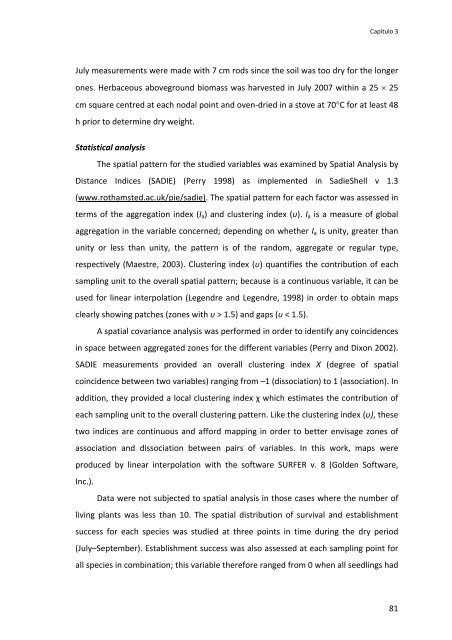Establecimiento de cuatro especies de Quercus en el sur de la ...
Establecimiento de cuatro especies de Quercus en el sur de la ...
Establecimiento de cuatro especies de Quercus en el sur de la ...
You also want an ePaper? Increase the reach of your titles
YUMPU automatically turns print PDFs into web optimized ePapers that Google loves.
Capítulo 3<br />
July mea<strong>sur</strong>em<strong>en</strong>ts were ma<strong>de</strong> with 7 cm rods since the soil was too dry for the longer<br />
ones. Herbaceous aboveground biomass was harvested in July 2007 within a 25 × 25<br />
cm square c<strong>en</strong>tred at each nodal point and ov<strong>en</strong>‐dried in a stove at 70°C for at least 48<br />
h prior to <strong>de</strong>termine dry weight.<br />
Statistical analysis<br />
The spatial pattern for the studied variables was examined by Spatial Analysis by<br />
Distance Indices (SADIE) (Perry 1998) as implem<strong>en</strong>ted in SadieSh<strong>el</strong>l v 1.3<br />
(www.rothamsted.ac.uk/pie/sadie). The spatial pattern for each factor was assessed in<br />
terms of the aggregation in<strong>de</strong>x (I a ) and clustering in<strong>de</strong>x (υ). I a is a mea<strong>sur</strong>e of global<br />
aggregation in the variable concerned; <strong>de</strong>p<strong>en</strong>ding on whether I a is unity, greater than<br />
unity or less than unity, the pattern is of the random, aggregate or regu<strong>la</strong>r type,<br />
respectiv<strong>el</strong>y (Maestre, 2003). Clustering in<strong>de</strong>x (υ) quantifies the contribution of each<br />
sampling unit to the overall spatial pattern; because is a continuous variable, it can be<br />
used for linear interpo<strong>la</strong>tion (Leg<strong>en</strong>dre and Leg<strong>en</strong>dre, 1998) in or<strong>de</strong>r to obtain maps<br />
clearly showing patches (zones with υ > 1.5) and gaps (υ < 1.5).<br />
A spatial covariance analysis was performed in or<strong>de</strong>r to i<strong>de</strong>ntify any coinci<strong>de</strong>nces<br />
in space betwe<strong>en</strong> aggregated zones for the differ<strong>en</strong>t variables (Perry and Dixon 2002).<br />
SADIE mea<strong>sur</strong>em<strong>en</strong>ts provi<strong>de</strong>d an overall clustering in<strong>de</strong>x X (<strong>de</strong>gree of spatial<br />
coinci<strong>de</strong>nce betwe<strong>en</strong> two variables) ranging from –1 (dissociation) to 1 (association). In<br />
addition, they provi<strong>de</strong>d a local clustering in<strong>de</strong>x χ which estimates the contribution of<br />
each sampling unit to the overall clustering pattern. Like the clustering in<strong>de</strong>x (υ), these<br />
two indices are continuous and afford mapping in or<strong>de</strong>r to better <strong>en</strong>visage zones of<br />
association and dissociation betwe<strong>en</strong> pairs of variables. In this work, maps were<br />
produced by linear interpo<strong>la</strong>tion with the software SURFER v. 8 (Gol<strong>de</strong>n Software,<br />
Inc.).<br />
Data were not subjected to spatial analysis in those cases where the number of<br />
living p<strong>la</strong>nts was less than 10. The spatial distribution of <strong>sur</strong>vival and establishm<strong>en</strong>t<br />
success for each species was studied at three points in time during the dry period<br />
(July–September). Establishm<strong>en</strong>t success was also assessed at each sampling point for<br />
all species in combination; this variable therefore ranged from 0 wh<strong>en</strong> all seedlings had<br />
81

















